If you’re on Windows 10 and your PC can’t detect or recognize your iPhone, or that you can’t see your iPhone content in your computer, you’re not alone. Many Windows users are reporting this problem as well. But no worries, it’s possible and even easy to fix.
Here are 5 fixes for you to try. You may not have to try them all; just work your way down until you find the one works for you.
Method 1: Reinstall the latest version of iTunes
Method 2: If your iPhone is listed under Other device and with  next to it
Method 3: If you see
next to it
Method 3: If you see  next to the Apple Mobile Device USB Driver
Method 4: Restart Apple Mobile Device Support and Service
Method 5: If you see
next to the Apple Mobile Device USB Driver
Method 4: Restart Apple Mobile Device Support and Service
Method 5: If you see  or
or next to Apple Mobile Device USB Driver
Before we begin, we would like you to make sure the following things:
1) You have clicked Trust this computer on your iPhone.
next to Apple Mobile Device USB Driver
Before we begin, we would like you to make sure the following things:
1) You have clicked Trust this computer on your iPhone.
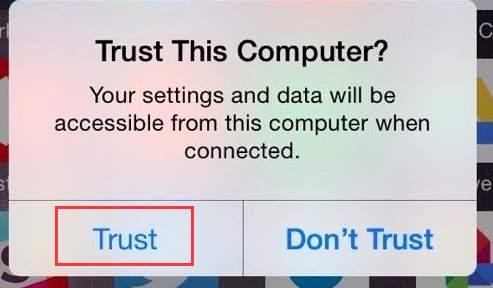
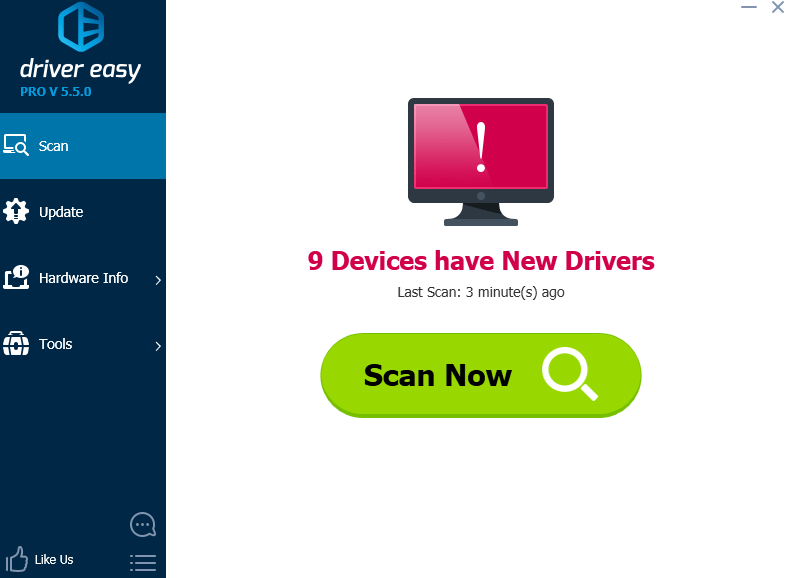 3) Click the Update button next to the flagged Apple Mobile device to automatically download and install the correct version of this driver (you can do this with the FREE version).
Or click Update All to automatically download and install the correct version of all the drivers that are missing or out of date on your system (this requires the Pro version – you’ll be prompted to upgrade when you click Update All).
3) Click the Update button next to the flagged Apple Mobile device to automatically download and install the correct version of this driver (you can do this with the FREE version).
Or click Update All to automatically download and install the correct version of all the drivers that are missing or out of date on your system (this requires the Pro version – you’ll be prompted to upgrade when you click Update All).
 here next to the device name, then this device is disabled. Please right-click Apple Mobile Device USB Driver and click Enable.
here next to the device name, then this device is disabled. Please right-click Apple Mobile Device USB Driver and click Enable.
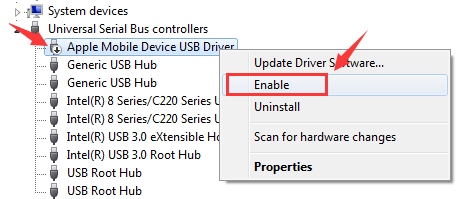 Note: If you cannot see any sign next to Apple Mobile Device USB Driver, please check if there is a third party software conflict.
Note: If you cannot see any sign next to Apple Mobile Device USB Driver, please check if there is a third party software conflict.
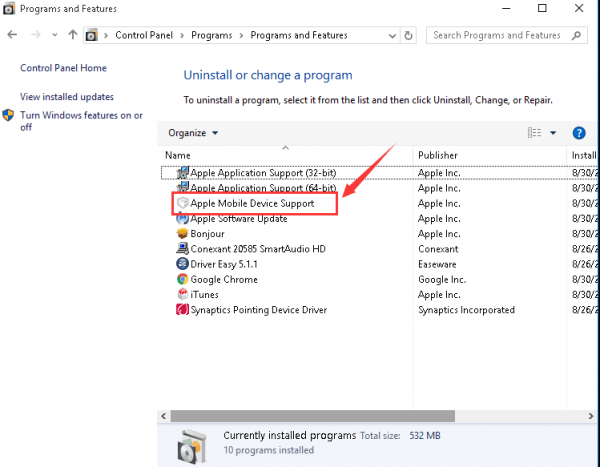 3) On your keyboard, press the Windows logo key and R at them same time, then type in services.msc and press Enter.
3) On your keyboard, press the Windows logo key and R at them same time, then type in services.msc and press Enter.
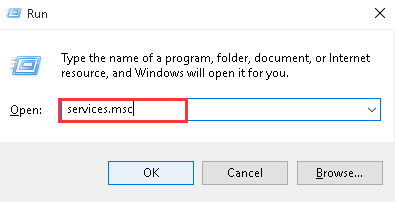 4) Double-click Apple Mobile Device or Apple Mobile Device Service.
4) Double-click Apple Mobile Device or Apple Mobile Device Service.
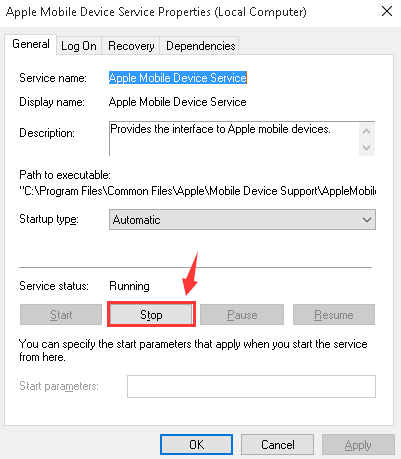 Then click Start button to restart the service.
Then click Start button to restart the service.
 or
or  by the Apple Mobile Device USB Driver.
by the Apple Mobile Device USB Driver.
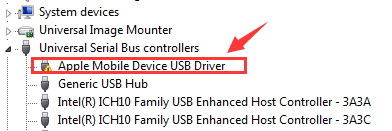 1) Make sure that you have quit iTunes if it opens. Then connect your iPhone to the computer.
2) Go to Device Manager. Expand Universal Serial Bus controllers and double-click Apple Mobile Device USB Driver.
1) Make sure that you have quit iTunes if it opens. Then connect your iPhone to the computer.
2) Go to Device Manager. Expand Universal Serial Bus controllers and double-click Apple Mobile Device USB Driver.
 If Apple Mobile Device USB Driver option cannot be found under category Universal Serial Bus controllers, but under Portable Devices, please go to Method Five: Update iPhone 7 Driver.
3) Click Browse my computer for driver software.
If Apple Mobile Device USB Driver option cannot be found under category Universal Serial Bus controllers, but under Portable Devices, please go to Method Five: Update iPhone 7 Driver.
3) Click Browse my computer for driver software.
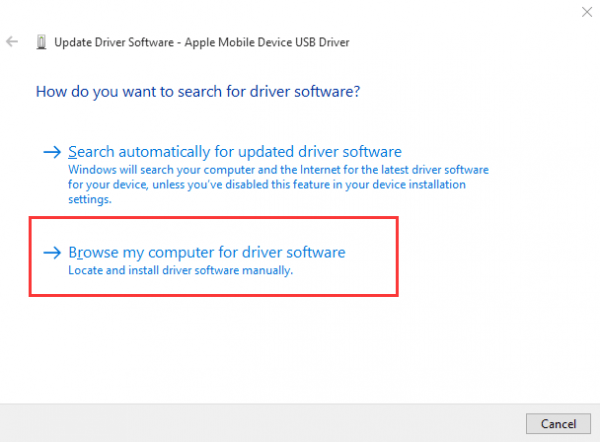 4) Click Let me pick from a list of device drivers on my computer.
4) Click Let me pick from a list of device drivers on my computer.
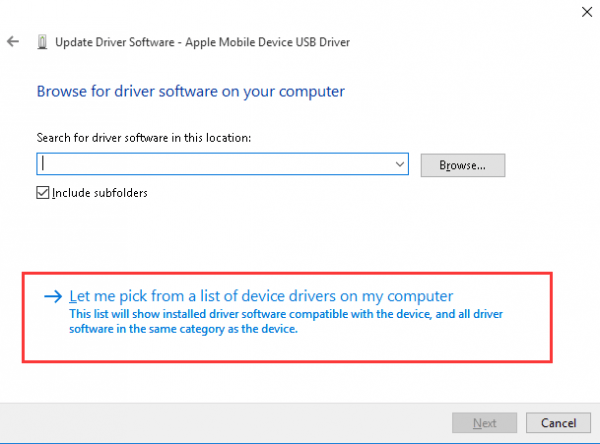 5) Click Have Disk….
5) Click Have Disk….
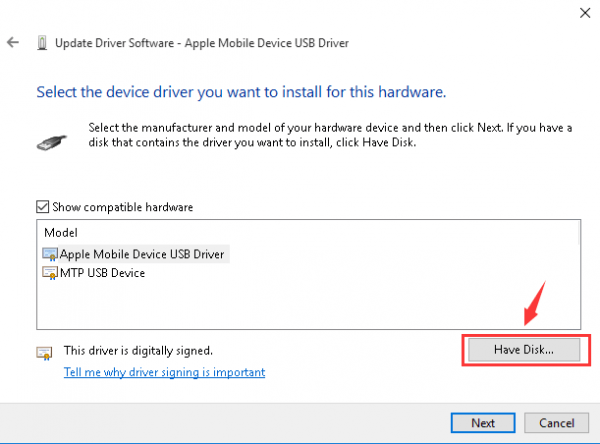 6) Click Browse.
6) Click Browse.
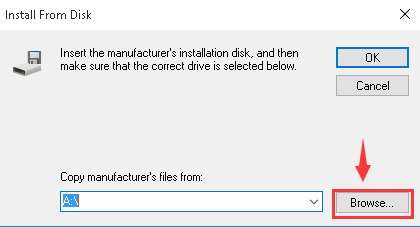 Go to C:\Program Files\Common Files\Apple\Mobile Device Support\Drivers.
Go to C:\Program Files\Common Files\Apple\Mobile Device Support\Drivers.
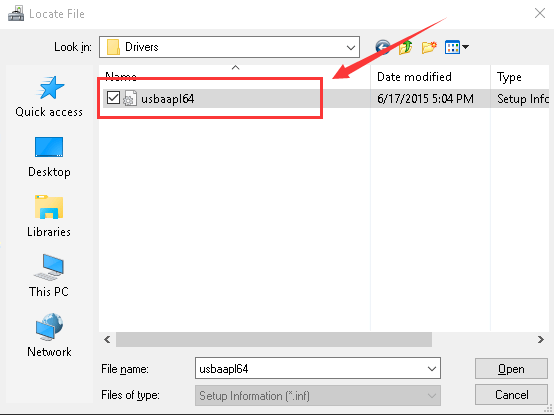 If you don’t see usbaapl64 here or if there isn’t a Drivers folder, look in C:\Program Files (x86)\Common Files\Apple\Mobile Device Support\Drivers.
8) You will be lead back to Install From Disk window. Click OK.
If you don’t see usbaapl64 here or if there isn’t a Drivers folder, look in C:\Program Files (x86)\Common Files\Apple\Mobile Device Support\Drivers.
8) You will be lead back to Install From Disk window. Click OK.
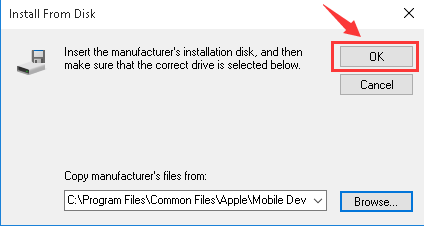 Click Next.
Click Next.
 9) Windows will install the driver. If it prompted to say that the software that you are installing has not passed Windows Logo testing, click Continue.
9) Windows will install the driver. If it prompted to say that the software that you are installing has not passed Windows Logo testing, click Continue.
 Unplug your iPhone 7, then reconnect it using USB cable. Open your iTunes and see if your iPhone 7 can be detected or recognized by iTunes.
Unplug your iPhone 7, then reconnect it using USB cable. Open your iTunes and see if your iPhone 7 can be detected or recognized by iTunes.
 next to it
Method 3: If you see
next to it
Method 3: If you see  next to the Apple Mobile Device USB Driver
Method 4: Restart Apple Mobile Device Support and Service
Method 5: If you see
next to the Apple Mobile Device USB Driver
Method 4: Restart Apple Mobile Device Support and Service
Method 5: If you see  or
or next to Apple Mobile Device USB Driver
Before we begin, we would like you to make sure the following things:
1) You have clicked Trust this computer on your iPhone.
next to Apple Mobile Device USB Driver
Before we begin, we would like you to make sure the following things:
1) You have clicked Trust this computer on your iPhone.

1: Reinstall the latest version of iTunes
To exclude the issue with iTunes, you had better reinstall iTunes instead of just upgrading it to the latest version. 1) Follow the path Start > Control Panel (in Category view) > Uninstall a program.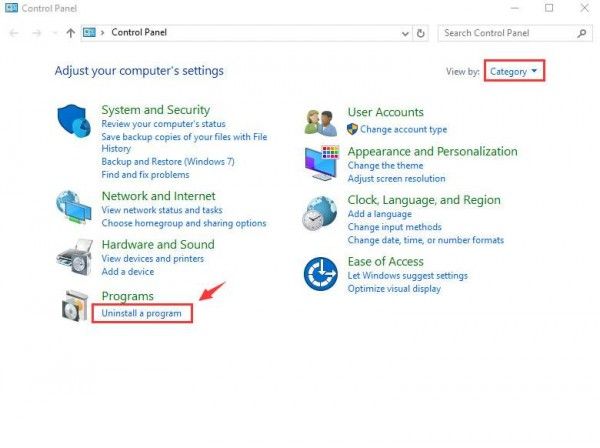
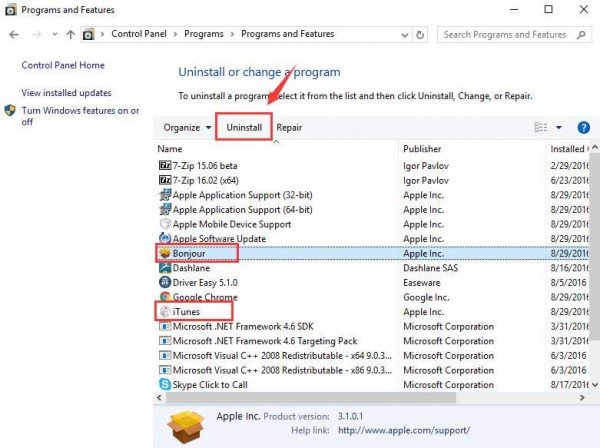
2: Update iPhone 7 Driver
This method applies when you see your iPhone, with a yellow exclamation mark next to it, listed under Portable Device rather than Universal Serial Bus controllers.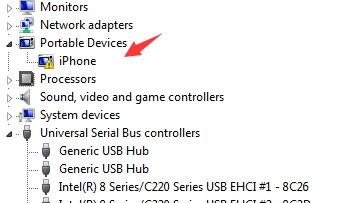
 3) Click the Update button next to the flagged Apple Mobile device to automatically download and install the correct version of this driver (you can do this with the FREE version).
Or click Update All to automatically download and install the correct version of all the drivers that are missing or out of date on your system (this requires the Pro version – you’ll be prompted to upgrade when you click Update All).
3) Click the Update button next to the flagged Apple Mobile device to automatically download and install the correct version of this driver (you can do this with the FREE version).
Or click Update All to automatically download and install the correct version of all the drivers that are missing or out of date on your system (this requires the Pro version – you’ll be prompted to upgrade when you click Update All).
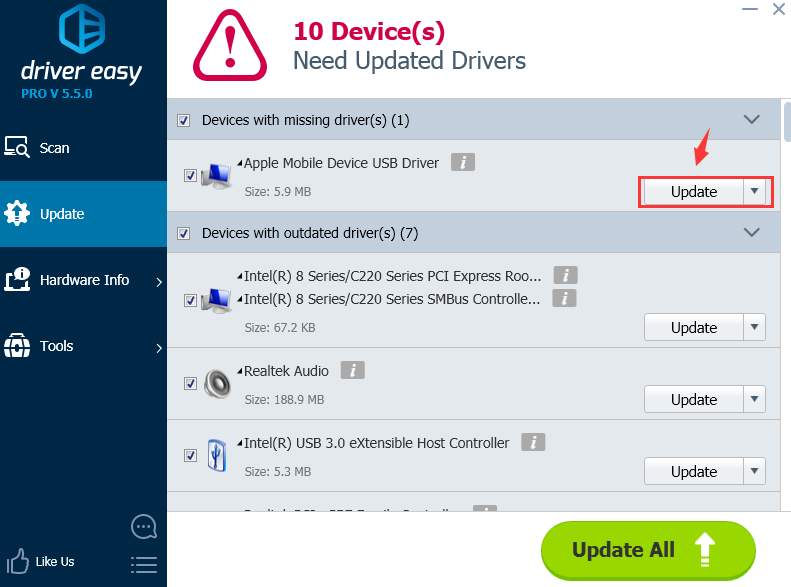
3: Enable Apple Mobile Device USB Driver
If you see a down arrow here next to the device name, then this device is disabled. Please right-click Apple Mobile Device USB Driver and click Enable.
here next to the device name, then this device is disabled. Please right-click Apple Mobile Device USB Driver and click Enable.
 Note: If you cannot see any sign next to Apple Mobile Device USB Driver, please check if there is a third party software conflict.
Note: If you cannot see any sign next to Apple Mobile Device USB Driver, please check if there is a third party software conflict.
4: Restart Apple Mobile Device Support and Service
Ill-functioning Apple Mobile Device service can be the cause of this problem. You can restart it and see if this problem is resolved. 1) Follow the path Start > Control Panel (in Category view) > Uninstall a program.
 3) On your keyboard, press the Windows logo key and R at them same time, then type in services.msc and press Enter.
3) On your keyboard, press the Windows logo key and R at them same time, then type in services.msc and press Enter.
 4) Double-click Apple Mobile Device or Apple Mobile Device Service.
4) Double-click Apple Mobile Device or Apple Mobile Device Service.
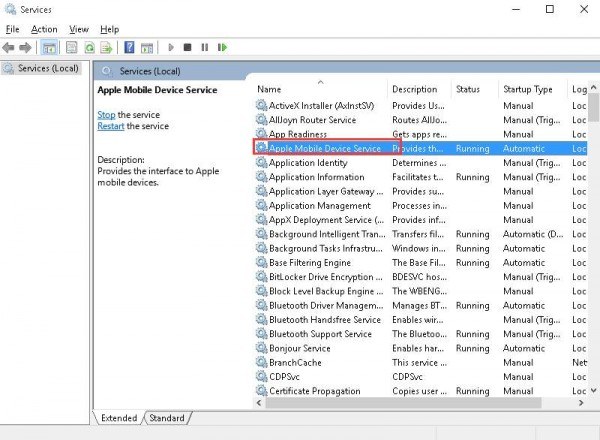
 Then click Start button to restart the service.
Then click Start button to restart the service.
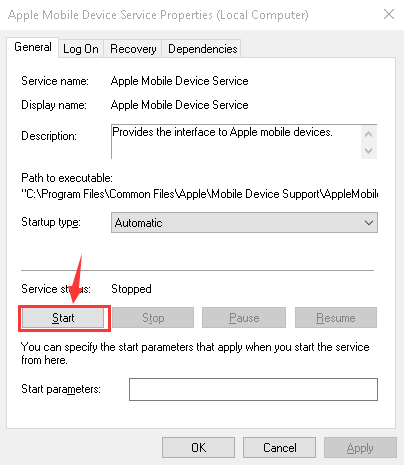
5: Reinstall Apple Mobile Device USB Driver
This method is adopted when you see a or
or  by the Apple Mobile Device USB Driver.
by the Apple Mobile Device USB Driver.
 1) Make sure that you have quit iTunes if it opens. Then connect your iPhone to the computer.
2) Go to Device Manager. Expand Universal Serial Bus controllers and double-click Apple Mobile Device USB Driver.
1) Make sure that you have quit iTunes if it opens. Then connect your iPhone to the computer.
2) Go to Device Manager. Expand Universal Serial Bus controllers and double-click Apple Mobile Device USB Driver.
 If Apple Mobile Device USB Driver option cannot be found under category Universal Serial Bus controllers, but under Portable Devices, please go to Method Five: Update iPhone 7 Driver.
3) Click Browse my computer for driver software.
If Apple Mobile Device USB Driver option cannot be found under category Universal Serial Bus controllers, but under Portable Devices, please go to Method Five: Update iPhone 7 Driver.
3) Click Browse my computer for driver software.
 4) Click Let me pick from a list of device drivers on my computer.
4) Click Let me pick from a list of device drivers on my computer.
 5) Click Have Disk….
5) Click Have Disk….
 6) Click Browse.
6) Click Browse.
 Go to C:\Program Files\Common Files\Apple\Mobile Device Support\Drivers.
Go to C:\Program Files\Common Files\Apple\Mobile Device Support\Drivers.
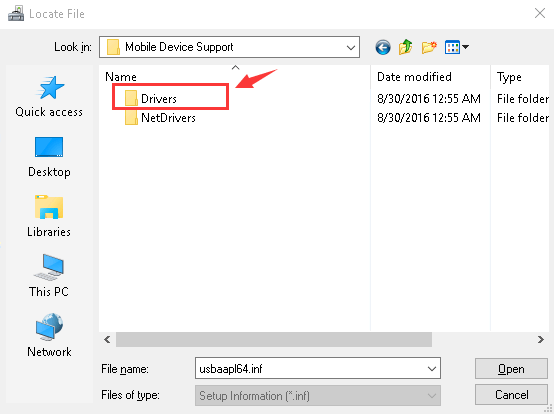
 If you don’t see usbaapl64 here or if there isn’t a Drivers folder, look in C:\Program Files (x86)\Common Files\Apple\Mobile Device Support\Drivers.
8) You will be lead back to Install From Disk window. Click OK.
If you don’t see usbaapl64 here or if there isn’t a Drivers folder, look in C:\Program Files (x86)\Common Files\Apple\Mobile Device Support\Drivers.
8) You will be lead back to Install From Disk window. Click OK.
 Click Next.
Click Next.
 9) Windows will install the driver. If it prompted to say that the software that you are installing has not passed Windows Logo testing, click Continue.
9) Windows will install the driver. If it prompted to say that the software that you are installing has not passed Windows Logo testing, click Continue.
 Unplug your iPhone 7, then reconnect it using USB cable. Open your iTunes and see if your iPhone 7 can be detected or recognized by iTunes.
Unplug your iPhone 7, then reconnect it using USB cable. Open your iTunes and see if your iPhone 7 can be detected or recognized by iTunes.
17
17 people found this helpful
23 Comments
Most Voted





